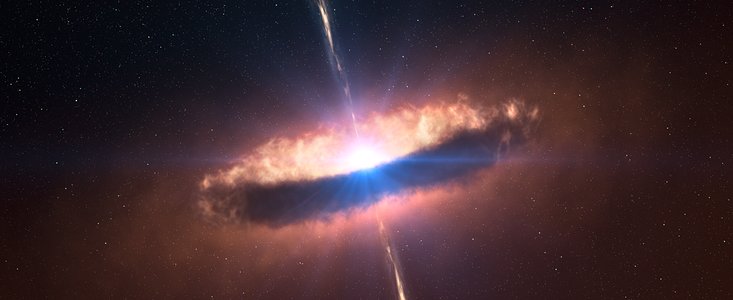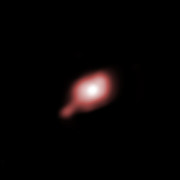Persbericht
De geboorte van een zware ster ontrafeld
Alle sterren ontstaan op dezelfde manier
14 juli 2010
Astronomen zijn er voor het eerst in geslaagd om de stofrijke schijf rond een zware babyster in beeld te brengen. Daarmee is het directe bewijs geleverd dat zware sterren op dezelfde manier ontstaan als hun kleinere soortgenoten. Deze ontdekking, die met behulp van een aantal ESO-telescopen is gedaan, staat beschreven in de Nature-editie van deze week.
‘Onze waarnemingen tonen een schijf rond een embryonale, zware ster die inmiddels geheel volgroeid is,’ zegt Stefan Kraus, die het onderzoek leidde. ‘Je zou kunnen zeggen dat de geboorte nabij is!’
Het team astronomen onderzocht een object dat bekend staat onder de cryptische naam IRAS 13481-6124. Deze jonge ster, die ongeveer twintig keer zo zwaar en vijf keer zo groot is als onze zon, en nog in zijn prenatale cocon gehuld is, staat in het sterrenbeeld Centaurus, op een afstand van ongeveer tienduizend lichtjaar.
Uit archiefbeelden van de Spitzer-ruimtetelescoop van de NASA en waarnemingen die met de APEX 12-meter submillimetertelescoop zijn gedaan, blijkt dat de ster een jet vertoont – een straalstoom van materie.
‘Zulke jets zijn vaak te zien bij jonge, lichte sterren en wijzen doorgaans op de aanwezigheid van een schijf,’ aldus Kraus.
Circumstellaire schijven zijn een essentieel ingrediënt van het vormingsproces van lichte sterren zoals onze zon. Maar het was onbekend of zulke schijven ook aanwezig zijn bij de vorming van sterren zwaarder dan ongeveer tien zonsmassa’s, waarvan de krachtige straling de aanvoer van materie naar de ster kan verhinderen. Daarom is wel geopperd dat zware sterren ontstaan door samensmelting van kleinere sterren.
Om deze schijf te ontdekken en de eigenschappen ervan te onderzoeken, hebben astronomen ESO’s Very Large Telescope Interferometer (VLTI) ingezet. Door het licht van drie van de 1,8-meter VLTI-hulptelescopen te combineren met het AMBER-instrument, stelt deze faciliteit astronomen in staat om details te zien die vergelijkbaar zijn met wat je door een telescoop met een 85 meter grote hoofdspiegel zou waarnemen. Dat resulteert in een oplossend vermogen van ongeveer 2,4 milliboogseconde, wat overeenkomt met de kop van een schroef in de romp van het internationale ruimtestation ISS. Daarmee is de beeldscherpte meer dan tien keer zo groot als die van de huidige optische telescopen in de ruimte.
Dankzij dit unieke waarnemingsvermogen en aanvullende waarnemingen met een andere ESO-telescoop – de 3,58-meter New Technology Telescope op La Silla – zijn Kraus en collega’s er in geslaagd om de schijf rond IRAS 13481-6124 te detecteren.
‘Het is voor het eerst dat we het binnengebied van de schijf rond een zware, jonge ster konden vastleggen’, zegt Kraus. ‘Onze waarnemingen tonen aan dat de vorming voor alle sterren op dezelfde manier verloopt, ongeacht de massa.’
De astronomen komen tot de conclusie dat het stelsel ongeveer 60.000 jaar oud is en dat de ster zijn uiteindelijke massa heeft bereikt. Vanwege de krachtige straling van de ster – 30.000 keer zo intens als die van onze zon – zal de schijf snel beginnen te verdampen. De wijd uitlopende schijf strekt zich uit over ongeveer 130 astronomische eenheden – 130 keer de afstand zon-aarde. Zijn massa is vergelijkbaar met die van de ster: ruwweg twintigmaal de massa van de zon. Uit de waarnemingen blijkt dat het binnendeel van de schijf verstoken is van stof.
‘Verdere waarnemingen met de Atacama Large Millimeter/submillimeter Array (ALMA), die momenteel in Chili wordt gebouwd, kunnen meer informatie opleveren over dat binnendeel, waardoor we beter gaan begrijpen hoe zware babysterren aan hun grote massa komen,’ besluit Kraus.
Meer informatie
Dit onderzoek is samengevat in een artikel dat deze week in het tijdschrift Nature verschijnt (‘A hot compact dust disk around a massive young stellar object’, door S. Kraus et al.).
Het onderzoeksteam bestaat uit Stefan Kraus (University of Michigan, VS), Karl-Heinz Hofmann, Karl M. Menten, Dieter Schertl, Gerd Weigelt, Friedrich Wyrowski en Anthony Meilland (Max-Planck-Institut für Radioastronomie, Bonn, Duitsland), Karine Perraut (Laboratoire d'Astrophysique de Grenoble, Frankrijk), Romain Petrov en Sylvie Robbe-Dubois (Université de Nice Sophia-Antipolis/CNRS/Observatoire de la Côte d’Azur, Frankrijk), Peter Schilke (Universität zu Köln, Duitsland) en Leonardo Testi (ESO).
ESO, de Europese Zuidelijke Sterrenwacht, is de belangrijkste intergouvernementele sterrenkundeorganisatie in Europa, en het meest productieve astronomische observatorium ter wereld. ESO wordt ondersteund door 14 landen: België, Denemarken, Duitsland, Finland, Frankrijk, Italië, Nederland, Oostenrijk, Portugal, Spanje, Tsjechië, het Verenigd Koninkrijk, Zweden en Zwitserland. ESO voert een ambitieus programma uit, gericht op het ontwerp, de bouw en het beheer van krachtige grondobservatoria die astronomen in staat stellen om belangrijke wetenschappelijke ontdekkingen te doen. ESO speelt ook een leidende rol bij het bevorderen en organiseren van samenwerking op sterrenkundig gebied. ESO beheert drie waarnemingslocaties van wereldklasse in Chili: La Silla, Paranal en Chajnantor. Op Paranal staat ESO’s Very Large Telescope (VLT), de meest geavanceerde optische sterrenwacht ter wereld. Ook is ESO de Europese partner van de revolutionaire telescoop ALMA. Daarnaast is ESO momenteel bezig met ontwerpstudies voor de 42-meter Europese Extremely Large optische/nabij-infrarood Telescoop (E-ELT), die ‘het grootste oog op de hemel’ ter wereld zal worden.
Links
Contact
Stefan Kraus
University of Michigan
USA
Tel: +1 734 615 7374
E-mail: stefankr@umich.edu
Richard Hook
ESO
Garching bei München, Germany
Tel: +49 89 3200 6655
E-mail: rhook@eso.org
Henri Boffin
ESO, La Silla Paranal and E-ELT Press Officer
Garching bei München, Germany
Tel: +49 89 3200 6222
Mob: +49 174 515 43 24
E-mail: hboffin@eso.org
Rodrigo Alvarez (press contact België)
ESO Science Outreach Network
en Planetarium, Royal Observatory of Belgium
Tel: +32-2-474 70 50
E-mail: eson-belgië@eso.org
Over dit bericht
| Persberichten nr.: | eso1029nl-be |
| Naam: | Protoplanetary disc |
| Type: | Milky Way : Star : Circumstellar Material : Disk : Protoplanetary |
| Facility: | New Technology Telescope, Very Large Telescope, Very Large Telescope Interferometer |
| Instruments: | AMBER, LABOCA, SABOCA |
| Science data: | 2010Natur.466..339K |
Our use of Cookies
We use cookies that are essential for accessing our websites and using our services. We also use cookies to analyse, measure and improve our websites’ performance, to enable content sharing via social media and to display media content hosted on third-party platforms.
ESO Cookies Policy
The European Organisation for Astronomical Research in the Southern Hemisphere (ESO) is the pre-eminent intergovernmental science and technology organisation in astronomy. It carries out an ambitious programme focused on the design, construction and operation of powerful ground-based observing facilities for astronomy.
This Cookies Policy is intended to provide clarity by outlining the cookies used on the ESO public websites, their functions, the options you have for controlling them, and the ways you can contact us for additional details.
What are cookies?
Cookies are small pieces of data stored on your device by websites you visit. They serve various purposes, such as remembering login credentials and preferences and enhance your browsing experience.
Categories of cookies we use
Essential cookies (always active): These cookies are strictly necessary for the proper functioning of our website. Without these cookies, the website cannot operate correctly, and certain services, such as logging in or accessing secure areas, may not be available; because they are essential for the website’s operation, they cannot be disabled.
Functional Cookies: These cookies enhance your browsing experience by enabling additional features and personalization, such as remembering your preferences and settings. While not strictly necessary for the website to function, they improve usability and convenience; these cookies are only placed if you provide your consent.
Analytics cookies: These cookies collect information about how visitors interact with our website, such as which pages are visited most often and how users navigate the site. This data helps us improve website performance, optimize content, and enhance the user experience; these cookies are only placed if you provide your consent. We use the following analytics cookies.
Matomo Cookies:
This website uses Matomo (formerly Piwik), an open source software which enables the statistical analysis of website visits. Matomo uses cookies (text files) which are saved on your computer and which allow us to analyze how you use our website. The website user information generated by the cookies will only be saved on the servers of our IT Department. We use this information to analyze www.eso.org visits and to prepare reports on website activities. These data will not be disclosed to third parties.
On behalf of ESO, Matomo will use this information for the purpose of evaluating your use of the website, compiling reports on website activity and providing other services relating to website activity and internet usage.
Matomo cookies settings:
Additional Third-party cookies on ESO websites: some of our pages display content from external providers, e.g. YouTube.
Such third-party services are outside of ESO control and may, at any time, change their terms of service, use of cookies, etc.
YouTube: Some videos on the ESO website are embedded from ESO’s official YouTube channel. We have enabled YouTube’s privacy-enhanced mode, meaning that no cookies are set unless the user actively clicks on the video to play it. Additionally, in this mode, YouTube does not store any personally identifiable cookie data for embedded video playbacks. For more details, please refer to YouTube’s embedding videos information page.
Cookies can also be classified based on the following elements.
Regarding the domain, there are:
- First-party cookies, set by the website you are currently visiting. They are stored by the same domain that you are browsing and are used to enhance your experience on that site;
- Third-party cookies, set by a domain other than the one you are currently visiting.
As for their duration, cookies can be:
- Browser-session cookies, which are deleted when the user closes the browser;
- Stored cookies, which stay on the user's device for a predetermined period of time.
How to manage cookies
Cookie settings: You can modify your cookie choices for the ESO webpages at any time by clicking on the link Cookie settings at the bottom of any page.
In your browser: If you wish to delete cookies or instruct your browser to delete or block cookies by default, please visit the help pages of your browser:
Please be aware that if you delete or decline cookies, certain functionalities of our website may be not be available and your browsing experience may be affected.
You can set most browsers to prevent any cookies being placed on your device, but you may then have to manually adjust some preferences every time you visit a site/page. And some services and functionalities may not work properly at all (e.g. profile logging-in, shop check out).
Updates to the ESO Cookies Policy
The ESO Cookies Policy may be subject to future updates, which will be made available on this page.
Additional information
For any queries related to cookies, please contact: pdprATesoDOTorg.
As ESO public webpages are managed by our Department of Communication, your questions will be dealt with the support of the said Department.





